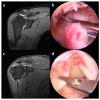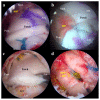Reinforcement Techniques in Arthroscopic Repair of Large-to-Massive Rotator Cuff Tears: A Comparative Study of Superior Capsule Reconstruction and Patch Graft Augmentation
- PMID: 38673549
- PMCID: PMC11050902
- DOI: 10.3390/jcm13082276
Reinforcement Techniques in Arthroscopic Repair of Large-to-Massive Rotator Cuff Tears: A Comparative Study of Superior Capsule Reconstruction and Patch Graft Augmentation
Abstract
Background: Large-to-massive rotator cuff tears (LMRCTs) present challenges in achieving successful repair due to factors such as muscle atrophy and tendon retraction. Arthroscopic rotator cuff repair (ARCR) with reinforcement techniques like superior capsule reconstruction (SCR) or patch graft augmentation (PGA) has emerged as a less invasive option to improve shoulder joint stability and prevent retear. This study aimed to compare the clinical and radiological outcomes of SCR and PGA as reinforcement techniques for the arthroscopic repair of LMRCTs. Methods: A single-center retrospective study was conducted on patients undergoing LMRCT repair between January 2019 and December 2021. Patients were divided into two groups: those receiving SCR (Group 1) and those receiving PGA (Group 2). Various clinical parameters including range of motion, functional scores, and radiological assessments were evaluated preoperatively and six months postoperatively. Results: Both SCR and PGA techniques demonstrated significant improvements in the range of motion and clinical scores postoperatively. However, Group 2 showed higher postoperative SST and UCLA scores compared to Group 1. Radiologically, there was a slightly higher retear rate in Group 2, although this was not statistically significant. Group 2 also had a shorter mean duration of surgery compared to Group 1. Conclusions: In the arthroscopic repair of LMRCTs, both SCR and PGA techniques exhibit favorable clinical and radiological outcomes. Despite the simplicity of PGA compared to SCR, it offers comparable results with a shorter surgical duration, making it a feasible reinforcement option for surgeons.
Keywords: arthroscopic rotator cuff repair; patch graft augmentation; reinforcement; rotator cuff tears; superior capsule reconstruction.
Conflict of interest statement
The authors declare no conflicts of interest. The funder was not involved in the study design, collection, analysis, interpretation of data, the writing of this article or the decision to submit it for publication.
Figures







References
-
- Oh J.H., Kim S.H., Kang J.Y., Oh C.H., Gong H.S. Effect of age on functional and structural outcome after rotator cuff repair. Am. J. Sports Med. 2010;38:672–678. - PubMed
Grants and funding
LinkOut - more resources
Full Text Sources

